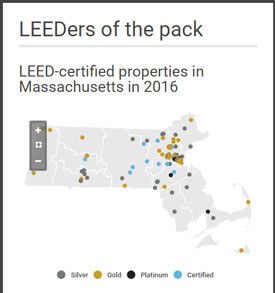
Credit: Boston Business Journals
Being green is an attribute that Boston landlords aspire to achieve, and do so at a national-leading rate.
From the BBJ:
Massachusetts had 136 properties spanning 24.4 million square feet achieve LEED certification last year. That represented 3.73 square feet of certified space per resident — the highest rate of any other state in the U.S….The ranking comes at a time of both significant deal-making activity in the region’s real estate capital markets industry and during one of the largest building booms in the city’s history.
“Sometimes what will happen is a broker tells an owner: ‘I can’t show this property because buyers only want LEED-certified properties,’” Lee said. “They’re using LEED as a mechanism to give their brokers a little extra ammunition in the marketplace. … LEED is a global brand, and people recognize it as a third-party accountability structure that helps all parties get their game to a better level. It’s part of what capital markets are looking for: how do you distinguish one asset from another?”
What does LEED mean? From Wikipedia:
Leadership in Energy and Environmental Design (LEED) is one of the most popular green building certification programs used worldwide.[7] Developed by the non-profit U.S. Green Building Council (USGBC) it includes a set of rating systems for the design, construction, operation, and maintenance of green buildings, homes, and neighborhoods[8] that aims to help building owners and operators be environmentally responsible and use resources efficiently.
